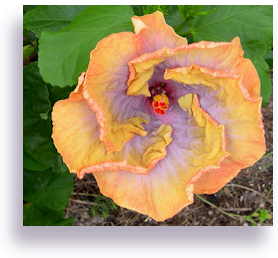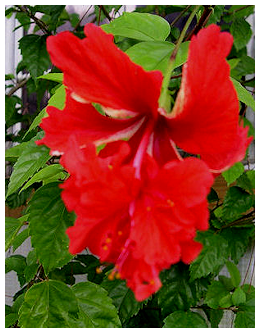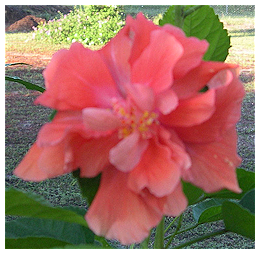Care of Hibiscus
 Hibiscus is a garden favorite for many reasons. The large disc shaped flowers nowadays sport every color of the rainbow, and edges of the blooms can be found furled, curled and crimped. Intensely rich colors have got to be the reason though, that so many people have made this plant one of the staples in their gardens.
Hibiscus is a garden favorite for many reasons. The large disc shaped flowers nowadays sport every color of the rainbow, and edges of the blooms can be found furled, curled and crimped. Intensely rich colors have got to be the reason though, that so many people have made this plant one of the staples in their gardens.
Hibiscus are placed into two groups, tropical and hardy. Knowing which you have can mean the difference between you being able to place it out in the landscape or having to bring it in for the winter. The care for the two groups is about the same, however.
A few differences that should be noted include hardy cultivars are generally of larger flower, and some even need a good chill in order to grow more vigorously when spring warmth returns. Hardy varieties will generally freeze to the ground after a hard frost, but their roots continue to live on and return. Most are deciduous, but a few do not die down and will keep their leaves.
Most species and cultivars, tropical and hardy, prefer moist, rich and loamy soil to grow in. There are a few exceptions to this, as some hardy cultivars will accept less moisture than the tropicals. I have a tropical that has adapted to the more sandy soils of Florida, and it is doing very well on just the rains and an occasional watering from me. From this, I know it is possible to get hibiscus to adapt to a new environment.
 Hibiscus thrives when fertilized on a regular basis. I use the fruit and nut tree spikes with micronutrients to feed mine once a year in spring. When they are new and getting established, I also add a weekly feeding of liquid fertilizer to the pot, to help build up a good root system and get them flowering. Regular feeding also helps to ward off pest insects like aphids and scale, which are common offenders of hibiscus.
Hibiscus thrives when fertilized on a regular basis. I use the fruit and nut tree spikes with micronutrients to feed mine once a year in spring. When they are new and getting established, I also add a weekly feeding of liquid fertilizer to the pot, to help build up a good root system and get them flowering. Regular feeding also helps to ward off pest insects like aphids and scale, which are common offenders of hibiscus.
When you water, look closely at the branches and leaves. If you see ants, blast them away from the plant with your watering hose. Pay special attention to the new leaves and buds. Ants cultivate aphids, and these are the prime locales on your precious hibiscus for the newest, sweetest plant juices for them to feed upon. If you do this rountinely, you should be able to keep the pests under control without the use of pesticides.
Since hardy hibiscus can be grown as far up the country as zone 4, many of you can own these lovely flowering plants. If you live in zones 4, 5 and 6, it is a good idea to heavily mulch the base of the plant before the first frost and snows arrive. This will protect the roots from freezing, and allow the plant to return again to bloom for you again in spring and summer.
Keep them moist and fed during their growing season, and in spring place half of a 40 lb. bag of compost at their feet and carefully rake it into the first inch or soil of the surrounding soil. Add a Fruit and Nut Plant Food spike, and keep the plant moderately moist. Blooms will arrive soon after.
Propagation of hibiscus is fairly easy. If you'd like to know more about taking cuttings and rooting your own hibiscus, visit Take Stem Cuttings. Rooting hibiscus is very similar to brugmansia. The only difference I will note here, is that on hibiscus you want to leave some of the smaller leaves on the top, halved with scissors.
Do take note that some cultivars or hybrids will not root from cuttings. For these, try air layering instead. Here is a link to a very talented individual who can teach you more about propagation of hibiscus Marcotting by Hibiscus World.
Below is a partial list of the Hardy Hibiscus Cultivars. Ones with the * are known to be deciduous to me
- Anne Arundel
- Aphrodite*
- Ardens*
- Blue River II
- Blush Satin*
- Bordeaux
- Brandy Punch
- Chablis
- Cherry Brandy
- Cinnamon Grappa
- Comfortroot
- Cranberry Crush
- Crimsoneyed Mallow
- Crown Jewels
- Diana
- Disco Belle series
- Fantasia
- Fireball*
- Flora Pena∼Confederate Rose
- Fleming hybrid
- Grenache
- Halberdleaf Rosemallow
- Hibiscus cannabinus
- Jazzberry Jam
- Kopper King*
- Lady Baltimore
- Lord Baltimore
- Lucy*
- Luna Blush White*
- Luna Pink
- Luna Pink Swirl*
- Luna Red
- Luna White
- Morning Star*
- Peppermint Schnapps
- Plum Crazy
- Pink Swirl*
- Pinot Grigio
- Pinot Noir
- Raspberry Rose
- Rose of Sharon*
- Rubra
- Scarlet rosemallow
- Sultry Kiss
- Summer Storm
- Summerific Berrylicious
- Super Rose
- Swamp Rosemallow
- Turn of the Century
- White Chiffon

Tags: hibiscus care, grow hibiscus,, hibiscus, hardy hibiscus, tropical hibiscus, care of hibiscus, jane cowell hibiscus, donna lynn hibiscus, buy hibiscus,


